
Chapter 7. Altered, corrected and unreadable text
Version 1.0 (20 May 2003)
7.1
Introduction
7.2 Additions,
deletions and substitutions
7.3 Additions,
deletions and substitutions made in the transcription of the
manuscript text
7.4 Damage and
illegibility
7.1 Introduction
This chapter deals with the encoding of additions, deletions and corrections made in the manuscript by the scribe or later users, or similar changes made in the transcription, e.g. by the transcriber or encoder of the manuscript text. Further, the chapter handles the encoding of damage to the manuscript that effects the reading of the manuscript text. In ch. 7.2 corrections, deletions and additions made by the scribe or later users of the manuscript are treated. Ch. 7.3 treats corrections, deletions and additions made by the transcriber of the manuscript text that have been made e.g. from other text witnesses or earlier editions of the text. In ch. 7.4 damage to the manuscript that effects the reading of the manuscript text are treated. The encoding recommended here is based onthe TEI Guidelines, ch. 18, where the following elements are defined:
Elements Contents <add> contains letters, words,
or phrases inserted in the manuscript text or in the margins
of the manuscript by an author, scribe, annotator or
corrector. <del> contains a letter, word or
passage deleted, marked as deleted, or otherwise indicated
as superfluous or spurious in the manuscript text by an
author, scribe, annotator or corrector. <supplied> signifies text supplied by
the transcriber, encoder or editor in place of text which
cannot be read, either because of physical damage or loss in
the original or because it is illegible for any reason. <sic> contains text reproduced
in the transcription although apparently incorrect or
inaccurate. <corr> contains the correct form
of a passage apparently erroneous in the manuscript text.
This element should only be used for corrections made in the
transcription or encoding of the manuscript text. It should
not be used for corrections made within the manuscript (e.g.
by the scribe or a later hand). <gap/> indicates a point where
material has been omitted in a transcription, normally
because the manuscript text is illegible, but potentially
for some other reason. <unclear> contains a word, phrase or
passage which cannot be transcribed with certainty because
it is illegible in the manuscript.
Within the tradition of medieval philology there are several different schools concerning the transcription and editing of texts. Scholars have construed different systems for handling the problems arising when phenomena within the manuscript should be rendered in a printed edition. When working with electronic transcriptions and encoding of manuscript texts the same problems are encountered, and although the electronic medium presents possibilities there are obviously parallels between the traditional transcription and editing and the work with electronic texts which could be used as starting points for a manual for handling the latter.
In a discussion on editorial practice for Old Norse texts Helle Jensen, with reference to Stefán Karlsson 1963, LXVII f., outlines aspects of the manuscript text which should be noted in an edition (Jensen 1988). Jensen's suggestions start with structural markup of e.g. linebreaks in the manuscript. She also gives special signs for each of the features that has to do with scribal or later changes in the manuscript as follows (Jensen 1988, 102 f.):
Sign Explanation ` ´ Includes something that
has been added above the line in the manuscript. ´ ` Includes something that
has been added in the margins. Unless stated in a footnote
these additions are considered to be the work of the hand
that has written the main text. |- -| Text that has been struck
through, underdotted or erased is placed within these
brackets. -| |- Text that has been written
twice without being marked by the scribe in the manuscript
is placed within these brackets. <> Text not present in the
exemplar, but supplied in the edition by the
editor. * The following word is
corrected by the editor. In a footnote the original form is
given. [ ] The text of the manuscript
is illegible due to use or damage. The text included could
be supplied from another manuscript or be a conjecture made
by the transcriber or editor. If the addition is made from
another manuscript it should be given diplomatically, if
from other sources, such as editions or transcriptions, it
should be rendered in a form normalized in accordance with
the manuscript text. [[
]] The text of the original
has been illegible at the time of a former diplomatic
transcription. Characters within double brackets have,
however, been legible at the time of the present
transcription. 000 Unreadable characters or
characters lost e.g. through damage to the manuscript. The
number of zeros corresponds to the number of characters
presumed missing. 000...000 The number of unreadable
characters is not known.
In addition, Helle Jensen suggests that uncertain readings should be subpunctuated. In editions from the Arnamagnæan Institutes in Reykjavík and Copenhagen these suggestions are in general followed, and in most editions of medieval Scandinavian texts similar systems are used. This gives us a starting point when we are transcribing Old Icelandic and Old Scandinavian manuscripts.
The principles presented in this handbook are based on the tradition of producing scholarly editions of texts and individual manuscripts. The system for printed editions outlined by Helle Jensen can therefore very often be translated into the electronic markup language presented in this chapter.
Text written in the margins can be of various kinds and of varying interest for our knowledge about the main text and the history of the manuscript. Notes on the main text in the margins are of course valuable when we are interested in the text tradition. Other notes could indicate that someone at a certain stage has used it for example in a transcription of the text.
In medieval manuscripts, however, we often also find notes in the margins that have nothing whatsoever to do with the manuscript text. These notes can at first sight seem to be of no value to philological investigation, but in a larger context they can sometimes give information as to where a manuscript has been at a certain stage of its history. If e.g. the same scribbles are found in a group of manuscripts where one of the manuscripts can be geographically pin-pointed, this could indicate the whereabouts of the whole group. Information of this kind can also lead to the establishing of new connections between manuscripts that were not previously seen as connected. There are thus good arguments for including information also on this kind of marginal note, but these are more properly contained in the manuscript description in the header (cf. ch. 10) than within the encoded transcription.
The first kind of notes, i.e. comments or additions to the main text, are often treated in foot-notes in printed editions. They are considered relevant to the reading of the text, and are therefore given in relation to the main text. Marginal notes that indicate the owner or user of the manuscript in any obvious way are often treated in the introduction to the edition as they are considered relevant to the history of the text or manuscript.
The third category of notes, the ones that do not seem to give any relevant information, is often excluded or treated only briefly in the introduction. This is of course a rational way to handle these scribbles when the printed edition sets the limits, and the information often is obscure and cannot be easily related to parallel information concerning other manuscripts. In the electronic transcription of a manuscript, however, there is no reason to make this limitation. The information can be given in the same way as for the other categories, and thereby give us the possibility to search for all kinds of obscure information.
Medieval manuscripts have often become damaged through use, sometimes with relevance for our reading of the text. Pieces of parchment may for example have been torn out, leaving a physical gap in the manuscript. Parts of the text may be illegible because of use or deliberate erasure, or they may be darkened to such an extent that the text is no longer readable. In printed editions, unreadable sections of a text are marked as suggested by Helle Jensen. In the introductions to printed editions problems related to illegible text and damage to the manuscript are often discussed at length. If there are other text witnesses these are often used to replace missing stretches of text. In a diplomatic transcription of a manuscript text, however, the missing or unreadable parts are most often just marked as such. In the following sections the relation between the traditional markup of these kinds of textual and editorial difficulties and electronic encoding will be obvious. It is therefore relevant to take traditional transcription and editing as a starting point for the electronic encoding of transcriptions of manuscript texts.
The primary aim of the following sections are to give recommendations for the transcription and encoding of manuscript texts. It does, however, in some instances also give recommendations for editorial encoding, e.g. markup that refers to corrections or additions made by the transcriber or encoder. It is therefore important to keep the transcription and encoding of the manuscript text on the one hand and on the other hand the editorial changes consistently separated, so that the former provides a starting point for the editorial work.
7.2 Additions, deletions and substitutions
In the manuscript text and in the margins of the manuscript we often find different kinds of corrections, deletions and additions that we want to encode. These changes can be divided into different groups depending on the nature of the change and its relevance for the reading of the manuscript text or our knowledge about the manuscript. The main division is between additions or substitutions to the manuscript text, within the text or in the margins, and deletions made in the manuscript text. The former should be marked with the <add> element while the latter should be marked with the <del> element. Additions and substitutions made by the transcriber or editor are treated in the following chapter (see ch. 7.3).
7.2.1 Additions
The following elements are recommended for describing additions made by the author of the text, a compiler, scribe, annotator or corrector in the manuscript text. The TEI Guidelines recommend the use of the <add> element to describe additions in the manuscript (ch. 18.1.4). In the following the use of <add> in relation to our recommended encoding of the individual word within the element <w> and on the three different levels <facs>, <dipl> and <norm> is treated.
Elements Contents <add> contains letters, words,
or phrases inserted in the manuscript text or in the margins
of the manuscript by an author, scribe, annotator or
corrector. Attributes include: hand signifies the agent which
made the addition. The values given to the attribute
hand are: scribe the agent writing the
marked part of the manuscript text. The scribal hands
defined within the manuscript should be defined in the
header (cf. ch.
10). main scribe the agent writing the
major part of the manuscript text in instances when there
are more than one scribe involved in the writing of the
manuscript. (author) the agent responsible for
creating the manuscript text in cases where the manuscript
contains original text. The role of the author as an active
agent is, however, rather rare in the Nordic medieval
manuscripts. compiler the agent responsible for
a longer interpolation made in the manuscript
text. annotator the agent responsible for
marginal notes that are comments to the manuscript
text. corrector the agent responsible for
later additions to the manuscript text, either in originally
empty space inline or in the margins. resp signifies the transcriber
or editor responsible for identifying the hand. This
information can also be given in the header (cf.
ch.
10). place indicates where the
addition is made. Suggested values include: inline the addition is made in a
space originally left empty by the scribe. supralinear the addition is made above
the line. infralinear the addition is made below
the line. marginleft the addition is made in
the left margin. marginright the addition is made in
the right margin. margintop the addition is made in
the top margin. marginbot the addition is made in
the bottom margin. overleaf the addition is made on
the other side of the leaf.
rend describes how the addition
should be displayed. The relevant value is: sequence the addition consists of a
sequence of letters, words, or phrases that should be
displayed as a unit. <span/> is an empty element. It is
recommended when marking up sequences of letters, words or
phrases that should be treated as units or overlap
structural borders in the markup, e.g. <w>,
<facs>, <dipl> or
<norm>. rend is used here to indicate
that the sequence equals an addition with the value add. type is used to indicate the
function of the <span/> element. Relevant values
are: start indicates that the
<span/> element starts a sequence. end indicates that the
<span/> element ends a sequence.
Additions which can be ascribed to the author of a text are rare in
Old Norse or Scandinavian medieval manuscripts. The additions being
described with the above-mentioned attribute hand will
therefore primarily be ascribed to the values scribe,
compiler, annotator or corrector as described
below.
Scribal additions are probably the most common changes to be recorded in the transcription and encoding of a manuscript text. These additions, made by the scribe(s) of a manuscript, could be encoded as in the passage from Rómverjasögur (AM 595 a-b 4to; f. 14r22); note that for the sake of clarity we limit the use of encoding to the relevant sequence):
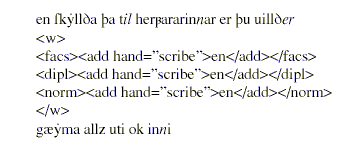
The addition is here given on all three levels within the <w> element. It is important to note, however, that once the information is given on one of the three levels it can be automatically generated for the remaining two levels.
The list of hands in the header (cf. ch. 10) should identify the individual hand, either as anonymous or, if possible, by name. The main hand in a manuscript could be marked as main scribe as follows:
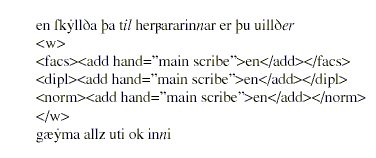
In the markup it is also possible to indicate where in the text the addition is made with the attribute place. An addition made over the line in the manuscript text should be described as follows:

Additions are sometimes made by an annotator, i.e. comments to the text. This kind of additions could be encoded as the marginal note “vantar ekkert F. J.” by Finnur Jónsson in Codex Wormianus (AM 242 fol. p. 60; here only presented on the <facs> level):
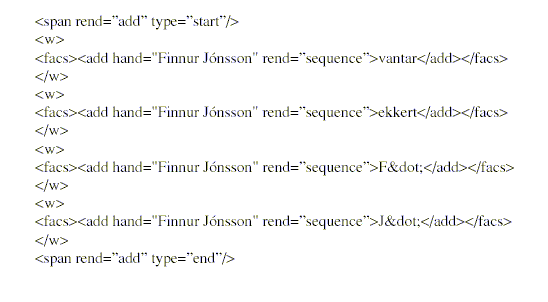
It is also possible to indicate with the attribute place where on the manuscript page the annotation is made. Finnur Jónsson's annotation that is made in the bottom margin should be encoded as follows:
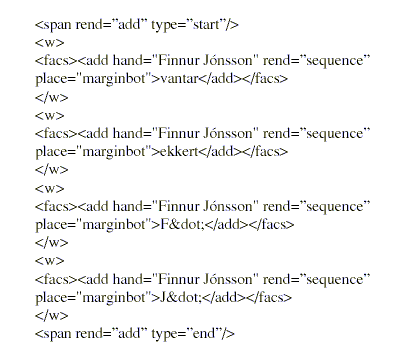
In cases where the addition reaches over structural boundaries in the manuscript, as in the example above, we recommend the use of the empty element <span/> used as indicated with the attributes rend that indicates how the sequence should be presented and type for the values start and end to delimit the sequence.
7.2.2 Deletions
The TEI Guidelines recommend the use of the <del> element to describe additions in the manuscript (ch. 18.1.4). In the following the use of <del> in relation to our recommended encoding of the individual word within the element <w> and on the three different levels <facs>, <dipl> and <norm> is treated.
Elements Contents <del> contains a letter, word or
passage deleted, marked as deleted, or otherwise indicated
as superfluous or spurious in the manuscript text by an
author, scribe, annotator or corrector. Attributes
include: hand signifies agent which made
the deletion. The roles given to the attribute hand
are: scribe the agent writing the
marked part of the manuscript text. The scribal hands
defined within the manuscript should be defined in the
header (cf. ch.
10). main scribe the agent writing the
major part of the manuscript text in instances when there
are more than one scribe involved in the writing of the
manuscript. The scribe can be described in the header (cf.
ch.
10). (author) the agent responsible for
creating the manuscript text in cases where the manuscript
contains original text. The role of the author is, however,
rather rare in the Nordic medieval manuscripts. corrector the agent responsible of
later deletions in the manuscript text. resp signifies the editor or
transcriber responsible for identifying the hand of the
restoration. This information can also be given in the
header (cf. ch.
10). type classifies the deletion,
using any convenient typology. Sample values include: overstrike the text has been struck
through. erasure the text has been
erased. bracketed deletion indicated by
brackets in the text or margin. subpunction deletion indicated by dots
beneath the letters deleted.
rend describes how the deletion
should be displayed. The relevant value is: sequence the deletion consists of a
sequence of letters, words, or phrases that should be
displayed as a unit. <span/> is an empty element. It is
recommended for use as a markup of sequences of letters,
words or phrases that should be treated as units or overlap
structural borders in the markup, e.g. <w>,
<facs>, <dipl> or
<norm>. rend is used here to indicate
that the sequence equals a deletion with the value
del. type is used to indicate the
function of the <span/> element. Relevant
attributes are: start indicates that the
<span/> element starts a sequence. end indicates that the
<span/> element ends a sequence.
Deletions that can be ascribed to the author of a manuscript text are
rare in Old Norse or Scandinavian medieval manuscripts. The deletions
being described with the above mentioned attribute hand will
therefore primarily be ascribed to scribe or
corrector.
Deletions made by the scribe(s) or corrector(s) of a manuscript could be encoded as in the passage from Rómverjasögur (AM 595 a-b 4to; Note that we for clarity limit the use of encoding to the relevant sequence, and that the encoding is only presented on the <facs> level):
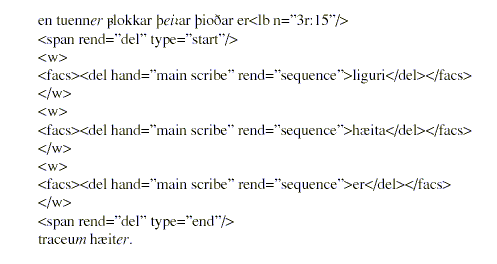
In the TEI Guidelines cited above there are a number of possible types of deletion described with the attribute type. These could be applied to deletions made both by scribe(s) and corrector(s). If a deletion is made e.g. by overstriking the deleted text it could be encoded as (here only presented on the <facs> level):
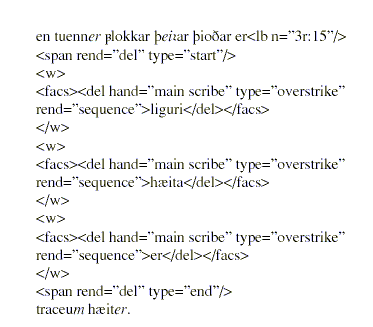
This could then be displayed on the computer screen or in a printed edition in the manner suggested by Helle Jensen (see above ch. 7.1):

The text that is marked as deleted must be at least partly legible in the manuscript so that it can be read by the transcriber. If the deleted text is not legible the deletion should be marked up with the <gap/> element, described below (00.4.1). The <gap/> element could be enclosed in the <del> element to indicate that the gap is in some way intentional. Parts of the deleted text that are legible could be indicated by the <unclear> element in combination with the <gap/> element as described below (ch. 7.4.2).
In cases where the deletion reaches over structural boundaries in the manuscript as in the example above we recommend the use of the empty element <span/> used as indicated with the attributes rend that indicates how the sequence should be presented and type for the values start and end to delimit the sequence.
7.2.3 Substitutions
In medieval manuscripts a rather common phenomenon is the combination of deleted text and added text. It is not always possible, however, to ascertain the relation between the two. If someone has deleted the originally written text inline this does not automatically mean that a corresponding addition above the line or in the margin is made by the same scribe. It can therefore not be stated as certain whether the correspondence is intentional or not. We suggest that substitutions made in the manuscript should be marked primarily with the two core tags <del> and <the add>. In cases where we can be relatively shure about the agent of the whole substitution this could be indicated with a combination of the <del> and <the add> elements as illustrated below.
If someone has deleted part of the manuscript text this could be encoded as has been demonstrated above (ch. 7.2.2), and if someone, the same hand or someone else in the manuscript transition, has supplied new text for the deletion, this could be encoded as in the following example from Codex Wormianus (AM 242 fol.; here only presented on the <facs> level):

In this case the attribute hand indicates that both the subpunction and the supralinear addition can be attributed to the scribe of the manuscript text.
7.3 Additions, deletions and substitutions made in the transcription of the manuscript text
When transcribing medieval material we often encounter words or longer sequences of text that we consider corrupt in one way or another. Sometimes it may also be obvious that text is missing in the manuscript we are transcribing or that the scribe has made a mistake. The transcriber of the manuscript text may in these instances wish to indicate the mistake or even correct the text, either directly from other versions of the same text or based on already existing editions of the text. Sometimes the transcriber or editor may also wish to make obvious grammatical corrections in the text without having any other text witness or precedence in an older edition. In the following the encoding of corrections made by the transcriber of the text or by an editor are treated. Note that we do not recommend the use of the attribute hand for the changes made in transcription or encoding of the manuscript text. The attribute resp should be used consistently for corrections or additions made in the transcription or encoding of the text to distinguish clearly between what is found in the manuscript text and what is made in the transcription and encoding of the text.
7.3.1 Additions made by the transcriber or editor
If text is obviously missing in the manuscript text we may wish to supply it. This could be based on for example another text witness or on a earlier edition of the text. The markup of such additions should give information about the source as well as about the responsibility for the addition. To encode additions made in the transcription we recommend the use of the <supplied> element as described in the TEI Guidelines (ch. 18.1.5). In the following the use of <supplied> in relation to our recommended encoding of the individual word within the element <w> and on the three different levels <facs>, <dipl> and <norm> is treated.
Elements Contents <supplied> signifies text supplied by
the transcriber, encoder or editor in place of text which
cannot be read, either because of physical damage or loss in
the original or because it is illegible for any reason.
Attributes include: source states the source of the
supplied text if this can be located. resp indicates the individual
responsible for the addition of letters, words or passages
contained within the <supplied> tag. It can be
given values like: transcriber the person responsible for
the transcription of the manuscript text. encoder the person responsible for
the encoding of the manuscript text. editor the editor of the text
used for the addition or responsible for the addition in
editing the manuscript text. reason indicates why the text has
had to be supplied agent where the presumed loss of
text leading to the supplying of text arises from an
identifiable cause, signifies the causative
agent.
rend describes how the
substitution should be displayed. The relevant attribute
is: <span/> is an empty element. It is
recommended for use as a markup of sequences of letters,
words or phrases that should be treated as units or overlap
structural borders in the markup, e.g. <w>,
<facs>, <dipl> or
<norm>. rend is used here to indicate
that the sequence equals a substitution with the value
supplied. type is used
to indicate the function of the <span/>
element. Relevant attributes are: start indicates that the
<span/> element starts a sequence. end indicates that the
<span/> element ends a sequence.
If the transcriber or editor wishes to supply text that is missing in
the transcribed manuscript text from for example another text witness
this could be handled with the <supplied> element. The
interpolated text could be transcribed as in this instance from
Rómverjasögur (AM 595 a–b 4to; Note that we for
clarity limit the use of encoding to the relevant sequence, and that
the encoding is only presented on the <facs>
level):
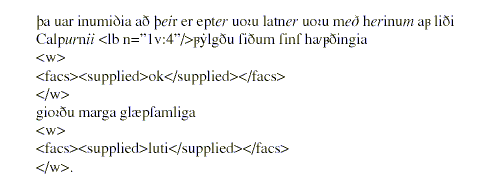
This could then be displayed on the computer screen or in a printed edition in the manner suggested by Helle Jensen (see ch. 7.1 above):

7.3.2 Corrections
In the manuscript it is not always
possible to say anything with certainty about the intention of
changes in the text. When transcribing the text, however, corrections
of obvious mistakes in the manuscript text could be marked with the
following tag set recommended in the TEI Guidelines (ch.
6.5.1). In the following
the use of <sic> and <corr> in relation to
our recommended encoding of the individual word within the element
<w> and on the three different levels
<facs>, <dipl> and <norm> is
treated. Elements Contents <sic> contains text reproduced
although apparently incorrect or inaccurate. The
<sic> element can also be used as an attribute
to the <corr> element as demonstrated
below. <corr> contains the correct form
of a passage apparently erroneous in the manuscript text.
The <corr> element can also be used as an
attribute to the <sic> element as demonstrated
below. resp indicates the individual
responsible for the correction of letters, words or passages
contained within the <corr> and
<sic> elements. It can be given values
like: transcriber the person responsible for
the transcription of the manuscript text. encoder the person responsible for
the encoding of the manuscript text. editor signifies the editor
responsible for suggesting the correction.
rend describes how incorrect
readings in the manuscript text should be displayed. The
relevant attribute is: sequence the incorrect reading in
the manuscript text consists of a sequence of letters,
words, or phrases that should be displayed as a unit. <span/> is an empty element. It is
recommended for use as a markup of sequences of letters,
words or phrases that should be treated as units or overlap
structural borders in the markup, e.g. <w>,
<facs>, <dipl> or
<norm>. rend is used here to indicate
that the sequence equals an incorrect reading in the
manuscript text with the value sic or
corr. type is used to indicate the
function of the <span/> element. Relevant
attributes are: start indicates that the
<span/> element starts a sequence. end indicates that the
<span/> element ends a sequence.
In a first-level transcription it can be relevant just to mark the
obviously corrupted instances in the manuscript text. This could be
done with the <sic> element as in this instance from
Rómverjasögur (AM 595 a-b 4to; Note that we for clarity
limit the use of encoding to the relevant sequence, and that the
encoding is only presented on the <facs>
level).

In this example the word uitier is marked as corrupt. There is no indication as to what is corrupt or how it should be corrected. The next step is to correct the corrupted instance, which could be made by combining the <sic> element with corr as an attribute.

This means that the correct reading of this passage should be as follows.

With this markup it is possible to show the text on the computer screen or in a printed edition in accordance with the suggestions of Helle Jensen (see above ch. 7.1)

with the corrected form from the manuscript text underneat the edited text:
![]()
It is also possible to include information about the person responsible for the correction with the attribute resp and its values:

It is, of course, also possible to use the <corr> element with sic as an attribute, but we recommend the use of the <sic> element.
7.4 Damage and illegibility
The following section deals with text omitted in the transcription or editing of text due to damage or illegibility in the manuscript, and text supplied from other sources such as other text witnesses or earlier editions.
7.4.1 Text omitted from or supplied in the transcription
When the manuscript is illegible we suggest the use of the elements <gap/> and <supplied> to indicate the illegible text, its extension and how it has been supplied (for the <supplied> element see ch. 7.3.1).
Elements Contents <gap/> is an element without
extention in the encoded manuscript text. It indicates a
point where material has been omitted in a transcription
because the manuscript text is illegible. Attributes
include: desc gives a description of the
omitted text. reason gives the reason for
omission. Sample values include: 'sampling', 'illegible',
'irrelevant', 'cancelled', 'cancelled and
illegible'. extent indicate approximately how
much text has been omitted from the transcription, in the
way that has been suggested by Helle Jensen refered to above
(ch.
7.1). Values can
be given as e.g. number of signs, number of lines or number
of pages in the manuscript. resp indicates the transcriber,
encoder or editor responsible for the decision not to
provide any transcription and hence the application of the
<gap/> element. hand in instances where text is
omitted from the transcription because of deliberate
deletion by an identifiable hand, this attribute signifies
the hand which made the deletion. agent in instances where text is
omitted from the transcription because of damage resulting
from an identifiable cause, this attribute signifies the
causative agent.
In medieval manuscripts we often find sections that for some reason are illegible. This can be due to e.g. damage or use. In the transcription we primarily wish to register the sections that are illegible and the extent of the illegibility. We suggest that the illegible sections should be indicated by the <gap/> element. The extent of the illegible section could be encoded as the following two lines from Völuspá in Hauksbók (AM 544 4to):

With this markup the extent of the illegible section is not defined. It can be presented on the computer screen or in a printed edition in the manner suggested by Helle Jensen (see above ch. 7.1):

If the transcriber or encoder of the text wishes to define the section more accurately it can be done as in the following example. The number of missing signs is given as a value to the attribute extent. It should be noted that the number given in the example is not intended as an exact evaluation of the number of signs missing in the present manuscript.

This could be represented as follows on the computer screen or in a printed edition. As the accuracy of this kind of evaluations is questionable it should not have the highest priority to show this in e.g. a printed edition.

In the above example there are other sources available for the illegible text. The text omitted can then be supplied from these sources within the <supplied> element as follows, where the supplied text is from Gustav Neckel's edition of the Edda (Hans Kuhn's revised 5. edition 1983, p. 13; Note that for clarity we limit the use of encoding to the relevant sequence, and that the encoding is only presented on the <facs> level).
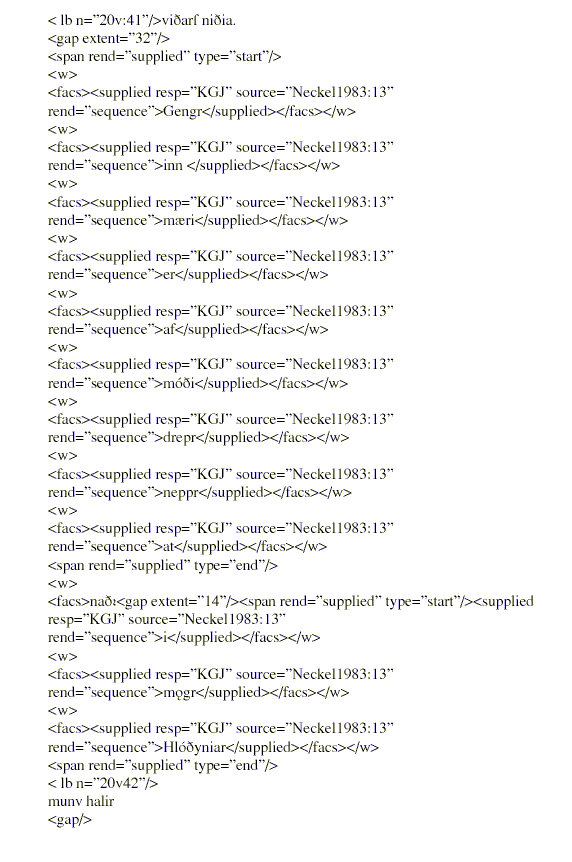
The second unreadable part in the manuscript text marked with <gap/> here starts within a word. The sequence that has been supplied therefore overlaps structural borders in the markup. By using the empty element <span/> this problem is solved. With this encoding it will be possible to display the text according to the recommendations of Helle Jensen refered to above, on the computer screen or in a printed diplomataric or normalised edition as shown in the following example.

This kind of editorial change is, however, not suggested as compulsory. In a primary transcription and encoding the use of the <gap/> element should only give the essential manuscript information. The attributes to <gap/> and <supplied>, such as source or resp, can of course be included voluntarily and to the extent that information is available.
7.4.2 Uncertain readings in the manuscript
In medieval manuscripts we often encounter problems of illegibility due to use or damage. In the following the encoding of such sequences is treated. To some extent this has already been treated in the above section (ch. 7.4.1). In cases where the text is readable to some extent the <gap/> and <supplied> elements should not be used. The TEI Guidelines (ch. 18.2.3) recommend that the <unclear> element is used for encoding damage and illegibility where the text of the dammaged or illegible area can be read with some certainty.
Elements Contents <unclear> contains a letter, word,
phrase or passage which cannot be transcribed with certainty
because it is illegible in the manuscript text. Attributes
include: reason indicates why the material
is hard to transcribe. resp indicates the individual
responsible for the transcription of the letter, word,
phrase or passage contained within the <unclear>
element. hand signifies the hand
responsible for the action where the difficulty in
transcription arises from action (partial deletion, etc.)
assignable to an identifiable hand. Note that this attribute
has the same function in the <del> element above
(ch.
7.2.2). agent where the difficulty in
transcription arises from an identifiable cause, signifies
the causative agent.
rend describes how the unclear
reading should be displayed. The relevant attribute is: sequence the unclear reading
consists of a sequence of letters, words, or phrases that
should be displayed as a unit. <span/> is an empty element. It is
recommended for use as a markup of sequences of letters,
words or phrases that should be treated as units or overlap
structural borders in the markup, e.g. <w>,
<facs>, <dipl> or
<norm>. rend is used here to indicate
that the sequence equals an unclear reading with the value
unclear. type is used to indicate the
function of the <span/> element. Relevant
attributes are: start indicates that the
<span/> element starts a sequence. end indicates that the
<span/> element ends a sequence.
The example given above from the version of Völuspá in Hauksbók (AM 544 4to) can be further encoded with the <unclear> element, to indicate that the text marked with the <unclear> element is read with some certainty while the <gap/> element indicates fully illegible text.
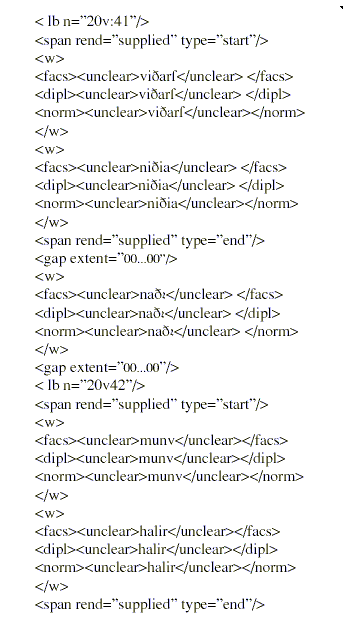
With this encoding the text could be presented with subpunction for all the words that the editor can not read with absolute certainty.
Preliminary version
created 29 January 2002. Version 1.0 published 20 May
2003.